Abstract
The diterpene diester phorbol 12-myristate 13-acetate and the alkaloid teleocidin B are structurally unrelated natural products that display similar potent irritant and tumor-promoting activities. Computer modeling of these and other structural classes of tumor promoters show a marked similarity in the relative positions of certain heteroatoms and hydrophobic groups. For phorbol this mapping consists of the C-4, C-9, and C-20 hydroxyl groups as well as a hydrophobic region filled by a long-chain acyl functionality attached to either the C-12 or the C-13 positions. Diacylglycerols, thought to be the endogenous activators of the major phorbol ester receptor protein kinase C likewise fit this model in a stereospecific fashion. As an initial test of the utility of the model, members of a new and simplified class of activators were synthesized that possess the predicted essential structural features. These compounds all inhibited specific phorbol ester binding to protein kinase C, albeit with low affinity (10-60 microM); further analysis of one derivative, decylhydroxylindole, confirmed that the inhibition of phorbol ester binding was competitive. This same derivative inhibited epidermal growth factor binding in intact Swiss 3T3 cells and studies with another derivative showed phosphorylation of a 40-kDa protein in platelets. Both of these in vivo responses are characteristic of phorbol esters.
Full text
PDF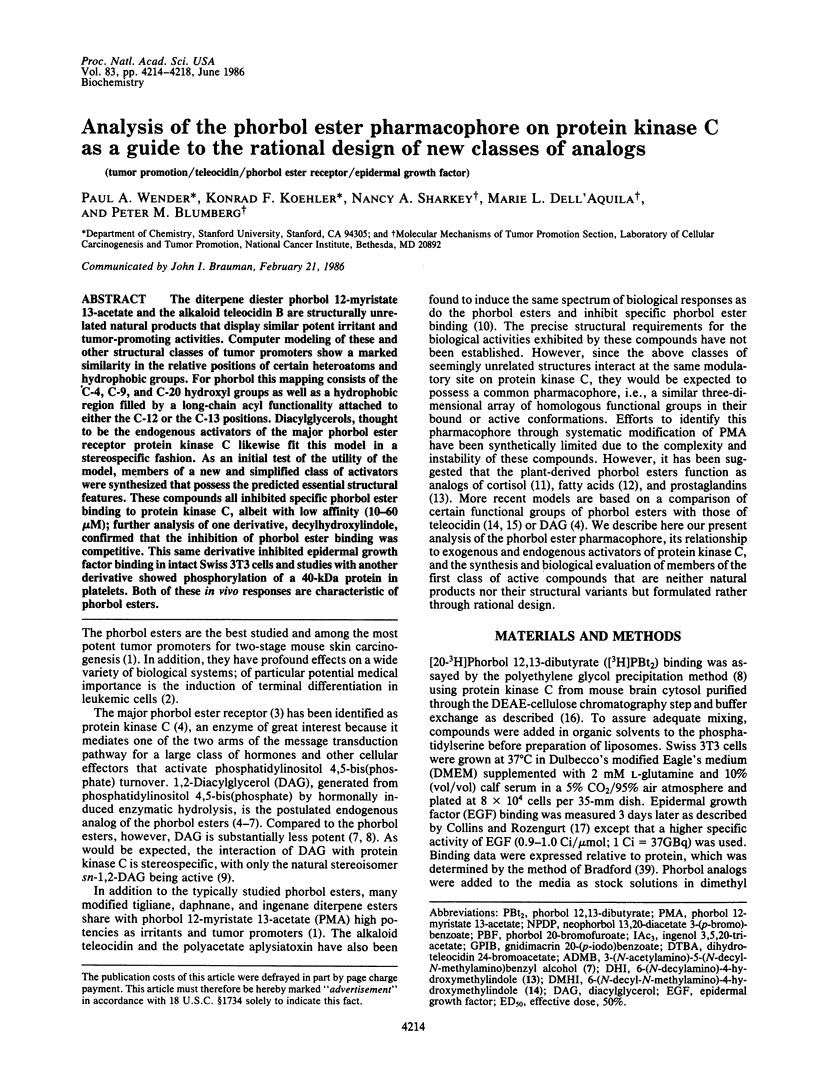
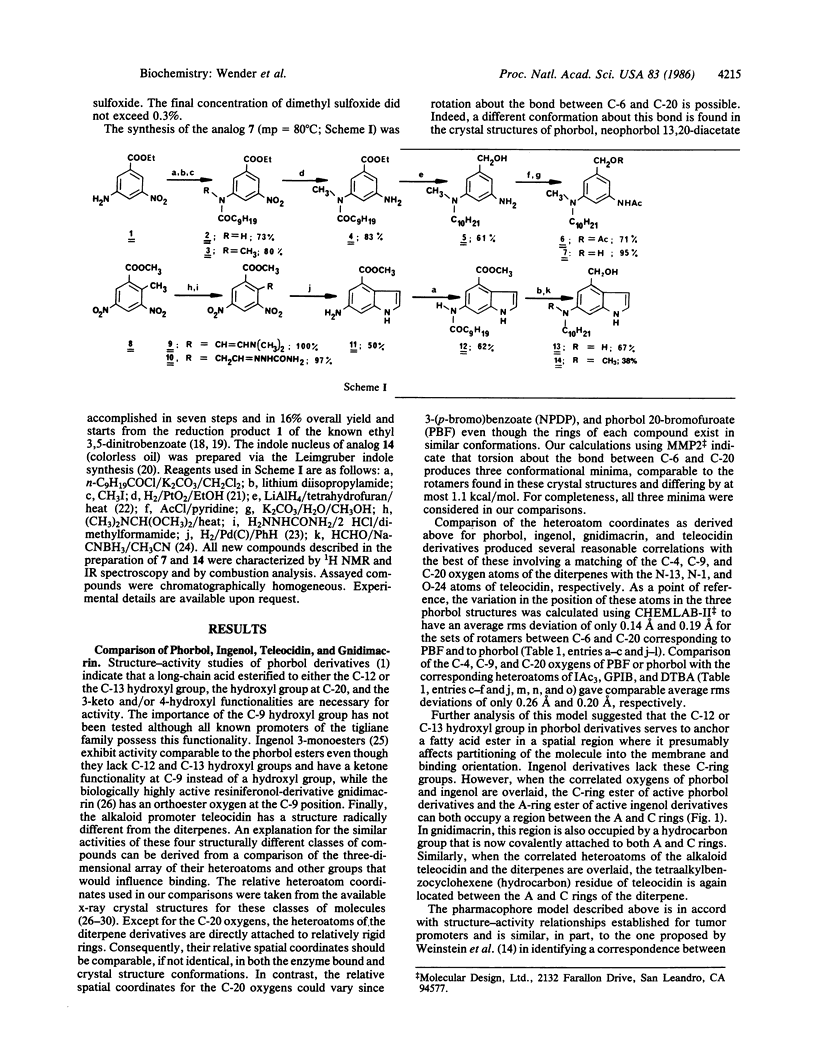
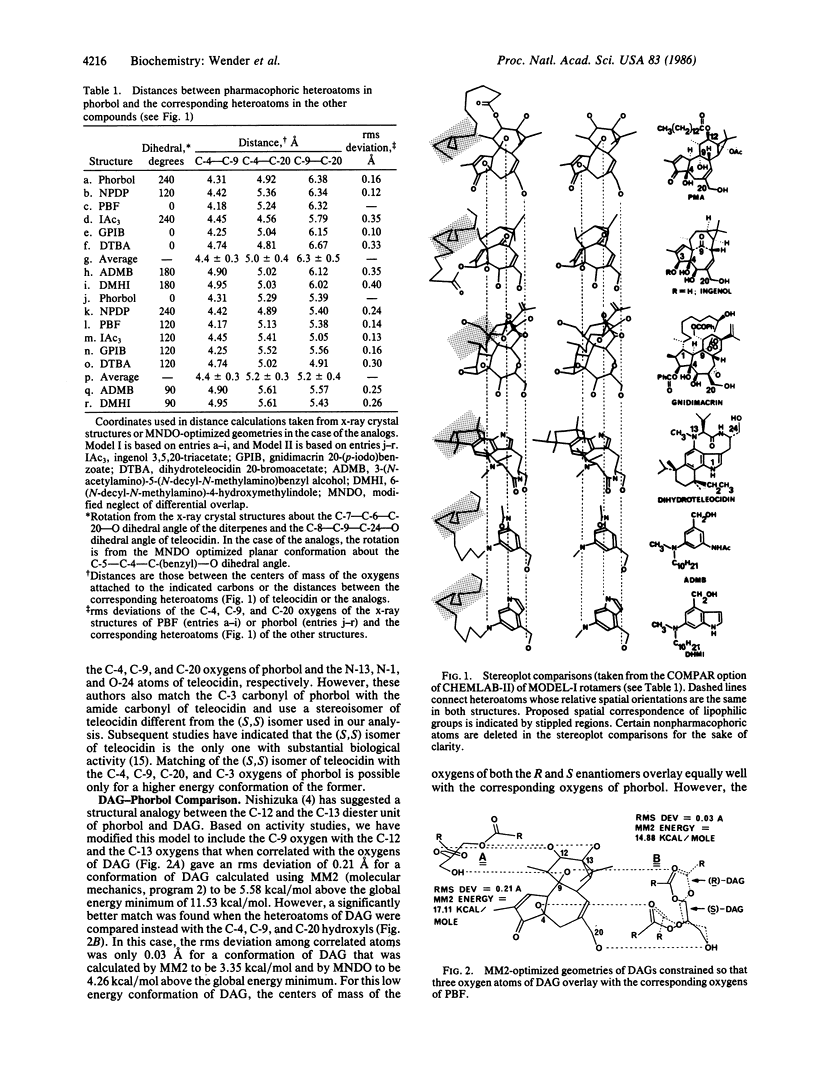
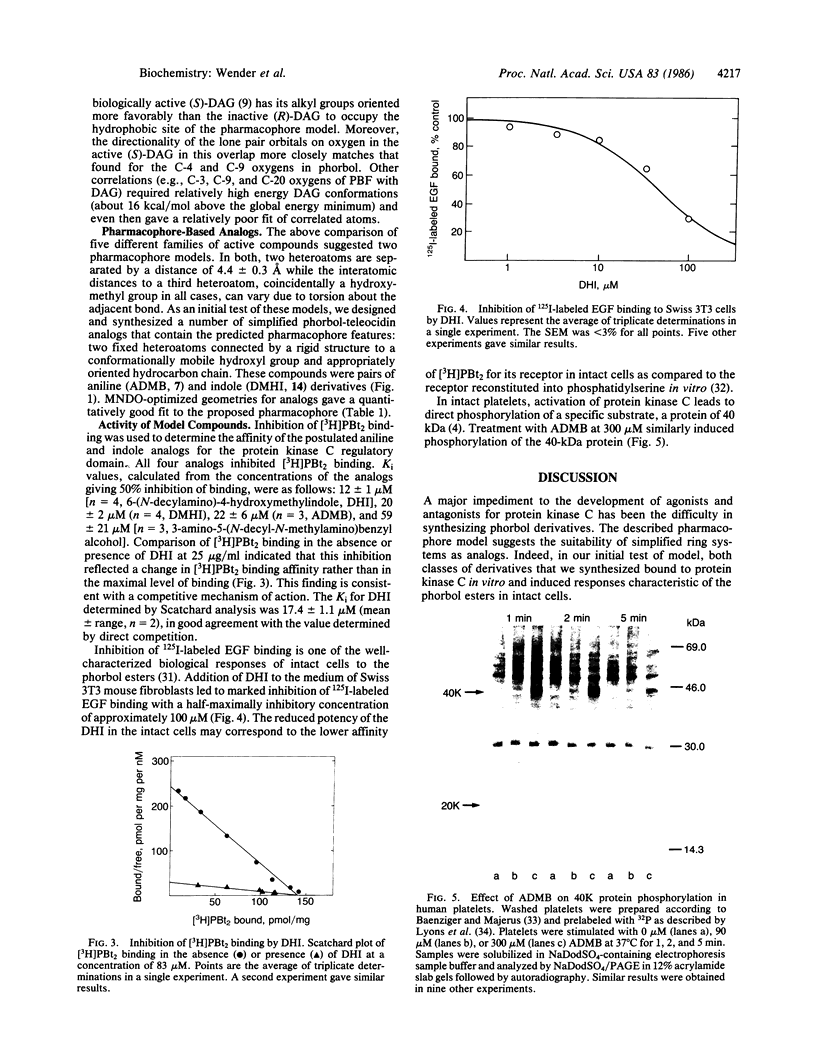
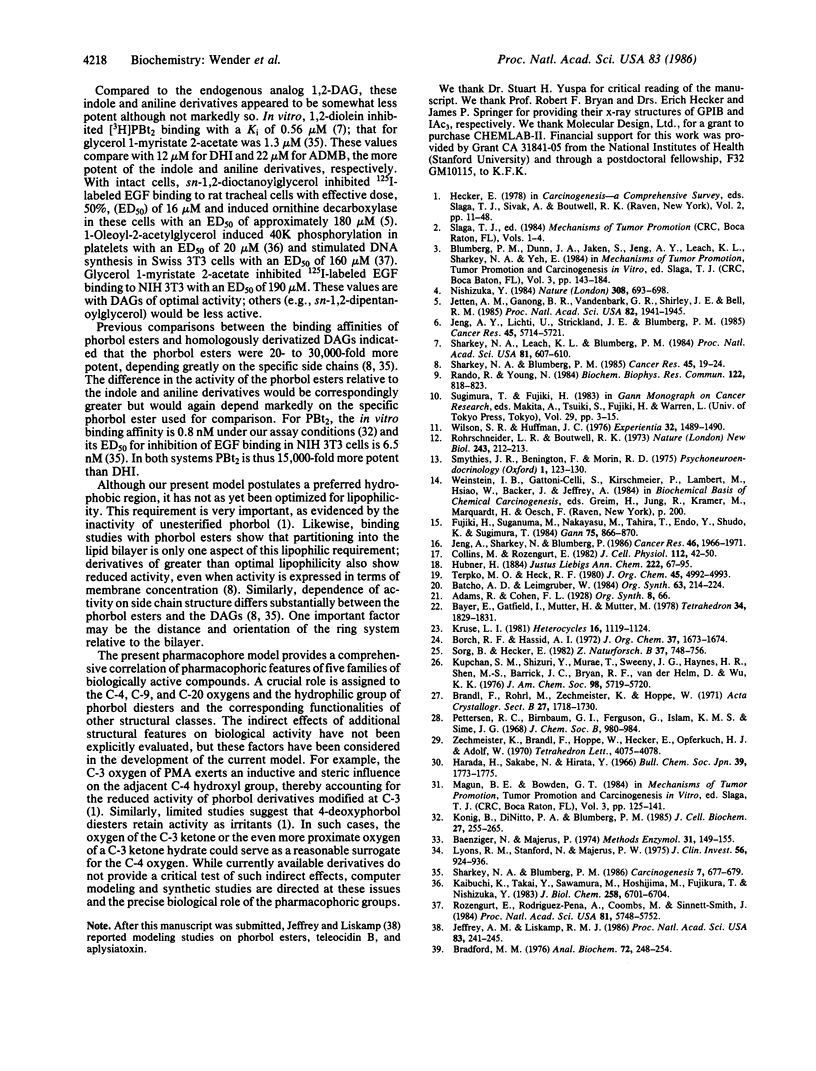
Images in this article
Selected References
These references are in PubMed. This may not be the complete list of references from this article.
- Baenziger N. L., Majerus P. W. Isolation of human platelets and platelet surface membranes. Methods Enzymol. 1974;31:149–155. doi: 10.1016/0076-6879(74)31015-4. [DOI] [PubMed] [Google Scholar]
- Bradford M. M. A rapid and sensitive method for the quantitation of microgram quantities of protein utilizing the principle of protein-dye binding. Anal Biochem. 1976 May 7;72:248–254. doi: 10.1016/0003-2697(76)90527-3. [DOI] [PubMed] [Google Scholar]
- Collins M. K., Rozengurt E. Binding of phorbol esters to high-affinity sites on murine fibroblastic cells elicits a mitogenic response. J Cell Physiol. 1982 Jul;112(1):42–50. doi: 10.1002/jcp.1041120108. [DOI] [PubMed] [Google Scholar]
- Fujiki H., Suganuma M., Nakayasu M., Tahira T., Endo Y., Shudo K., Sugimura T. Structure-activity studies on synthetic analogues (indolactams) of the tumor promoter teleocidin. Gan. 1984 Oct;75(10):866–870. [PubMed] [Google Scholar]
- Jeffrey A. M., Liskamp R. M. Computer-assisted molecular modeling of tumor promoters: rationale for the activity of phorbol esters, teleocidin B, and aplysiatoxin. Proc Natl Acad Sci U S A. 1986 Jan;83(2):241–245. doi: 10.1073/pnas.83.2.241. [DOI] [PMC free article] [PubMed] [Google Scholar]
- Jeng A. Y., Lichti U., Strickland J. E., Blumberg P. M. Similar effects of phospholipase C and phorbol ester tumor promoters on primary mouse epidermal cells. Cancer Res. 1985 Nov;45(11 Pt 2):5714–5721. [PubMed] [Google Scholar]
- Jeng A. Y., Sharkey N. A., Blumberg P. M. Purification of stable protein kinase C from mouse brain cytosol by specific ligand elution using fast protein liquid chromatography. Cancer Res. 1986 Apr;46(4 Pt 2):1966–1971. [PubMed] [Google Scholar]
- Jetten A. M., Ganong B. R., Vandenbark G. R., Shirley J. E., Bell R. M. Role of protein kinase C in diacylglycerol-mediated induction of ornithine decarboxylase and reduction of epidermal growth factor binding. Proc Natl Acad Sci U S A. 1985 Apr;82(7):1941–1945. doi: 10.1073/pnas.82.7.1941. [DOI] [PMC free article] [PubMed] [Google Scholar]
- Kaibuchi K., Takai Y., Sawamura M., Hoshijima M., Fujikura T., Nishizuka Y. Synergistic functions of protein phosphorylation and calcium mobilization in platelet activation. J Biol Chem. 1983 Jun 10;258(11):6701–6704. [PubMed] [Google Scholar]
- Kupchan S. M., Shizuri Y., Murae T., Swenny J. G., Haynes H. R., Shen M. S., Barrick J. C., Bryan A. F., vander Helm D., Wu K. K. Letter: Gnidimacrin and gnidimacrin 20-palmitate, novel macrocyclic antileukemic diterpenoid esters from Gnidia subcordata1,2. J Am Chem Soc. 1976 Sep 1;98(18):5719–5720. doi: 10.1021/ja00434a063. [DOI] [PubMed] [Google Scholar]
- König B., Di Nitto P. A., Blumberg P. M. Phospholipid and Ca++ dependency of phorbol ester receptors. J Cell Biochem. 1985;27(3):255–265. doi: 10.1002/jcb.240270307. [DOI] [PubMed] [Google Scholar]
- Lyons R. M., Stanford N., Majerus P. W. Thrombin-induced protein phosphorylation in human platelets. J Clin Invest. 1975 Oct;56(4):924–936. doi: 10.1172/JCI108172. [DOI] [PMC free article] [PubMed] [Google Scholar]
- Nishizuka Y. The role of protein kinase C in cell surface signal transduction and tumour promotion. Nature. 1984 Apr 19;308(5961):693–698. doi: 10.1038/308693a0. [DOI] [PubMed] [Google Scholar]
- Rando R. R., Young N. The stereospecific activation of protein kinase C. Biochem Biophys Res Commun. 1984 Jul 31;122(2):818–823. doi: 10.1016/s0006-291x(84)80107-2. [DOI] [PubMed] [Google Scholar]
- Rozengurt E., Rodriguez-Pena A., Coombs M., Sinnett-Smith J. Diacylglycerol stimulates DNA synthesis and cell division in mouse 3T3 cells: role of Ca2+-sensitive phospholipid-dependent protein kinase. Proc Natl Acad Sci U S A. 1984 Sep;81(18):5748–5752. doi: 10.1073/pnas.81.18.5748. [DOI] [PMC free article] [PubMed] [Google Scholar]
- Sharkey N. A., Blumberg P. M. Comparison of the activity of phorbol 12-myristate 13-acetate and the diglyceride glycerol 1-myristate 2-acetate. Carcinogenesis. 1986 Apr;7(4):677–679. doi: 10.1093/carcin/7.4.677. [DOI] [PubMed] [Google Scholar]
- Sharkey N. A., Blumberg P. M. Highly lipophilic phorbol esters as inhibitors of specific [3H]phorbol 12,13-dibutyrate binding. Cancer Res. 1985 Jan;45(1):19–24. [PubMed] [Google Scholar]
- Sharkey N. A., Leach K. L., Blumberg P. M. Competitive inhibition by diacylglycerol of specific phorbol ester binding. Proc Natl Acad Sci U S A. 1984 Jan;81(2):607–610. doi: 10.1073/pnas.81.2.607. [DOI] [PMC free article] [PubMed] [Google Scholar]
- Smythies J. R., Benington F., Morin R. D. On the molecular structure of receptors for co-carcinogens and some anti-cancer drugs. Psychoneuroendocrinology. 1975;1(2):123–130. doi: 10.1016/0306-4530(75)90004-9. [DOI] [PubMed] [Google Scholar]
- Wilson S. R., Huffman J. C. The structural relationship of phorbol and cortisol: a possible mechanism for the tumor promoting activity of phorbol. Experientia. 1976 Dec 15;32(12):1489–1490. doi: 10.1007/BF01924408. [DOI] [PubMed] [Google Scholar]



